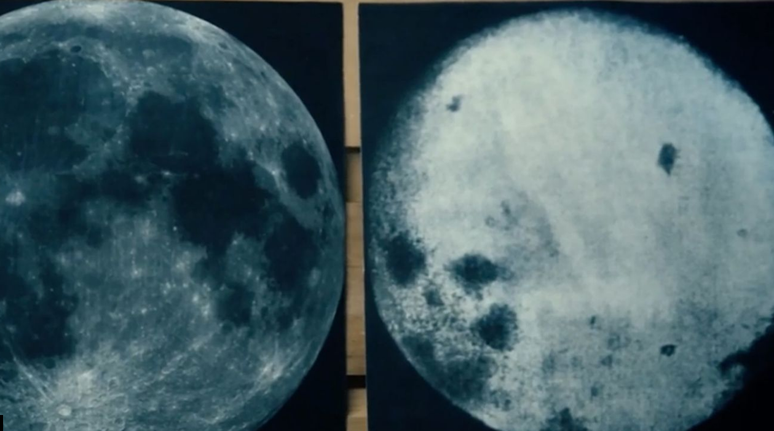Under the reverse influence of the tides it generates, our natural satellite is receding from the Earth by about 4 centimeters per year, scientists estimate.
Throughout human history, the Moon has always been a mysterious and inseparable presence on Earth. Its gentle gravitational pull marks the rhythm of the tides and its pale light illuminates the nocturnal nuptial rituals of many species.
Entire civilizations have set their calendars around the Moon as it comes and goes. Some animals, such as dung beetles, use sunlight reflected from the lunar surface to guide them.
More fundamentally, some theories state that the Moon may have helped create the conditions that made life possible on our planet and even started life on Earth.
Its eccentric orbit around our planet is also thought to influence some of the important weather systems that dominate our lives today.


But the Moon is also moving away from us. With each lap of its remarkably balanced space ballet around the Earth – in circles, but always without pirouettes, which explains why we always see the same side of the Moon – it gradually moves away from our planet, in a process known as “lunar recession”.
By firing lasers on reflectors installed on the lunar surface by Apollo astronauts, scientists were recently able to measure with absolute precision the exact rate of retreat of the Moon. They confirmed that the Moon is moving away at a rate of 3.8 cm per year. And as that happens, our days get longer and longer.
“It’s about the tides,” says David Waltham, a professor of geophysics at the University of London Royal Holloway who studies the relationship between the Moon and the Earth.
“The tidal force on the Earth reduces its rotation and the Moon receives this energy in the form of an angular impulse,” he adds.
Basically, as the Earth rotates, the gravity of the Moon orbiting our planet pushes the oceans to create high and low tides. These tides, in fact, are “volumes” of water that extend in an elliptical shape, against or in favor of the lunar gravity.
But the Earth rotates on its axis much faster than the orbit of the Moon, which means that the friction of our planet’s moving ocean basins also drags water along with them. With this, the volume of water moves slightly in front of the Moon in its orbit, which tries to pull it back.
This process slowly absorbs energy from our planet’s rotation, slowing it down, while the Moon gains energy, causing it to move into a higher orbit.
This continued slowdown in our planet’s rotational speed means that the length of the average day on Earth has increased by about 1.09 milliseconds per century since the late 1600s, according to the latest available analysis.
Other estimates put the figure slightly higher, at 1.78ms per century, based on older eclipse observations.
None of these numbers seem worrisome, but in the 4.5 billion year history of the planet, the accumulated change is very significant.
The Moon is believed to have formed about 50 million years after the birth of the Solar System.
The most accepted theory is that a collision between the forming Earth and another object approximately the size of the planet Mars, known as Theia, tore off a chunk of material and fragments that aggregated to form what we now call the Moon.
Longer distance and longer days
What is clear from geological data preserved in rock bands on Earth is that the Moon was much closer to Earth in the past than it is today.
Currently, the Moon is 384,400 km from the Earth. But a recent study indicates that about 3.2 billion years ago – when Earth’s tectonic plates were starting to shift and oceanic microorganisms were gobbling up nitrogen – the Moon was only 270,000 km from Earth, or about 70% of the your current distance.
“Earth’s faster rotation has shortened the length of the day, therefore [em um período de 24 horas]the sun rose and set twice, not just once, as it does today,” explains geophysicist Tom Eulenfeld, who led the study at the Friedrich Schiller University of Jena, Germany.
“This may have reduced the temperature difference between day and night and affected the biochemistry of photosynthetic organisms,” according to Eulenfeld.
What studies like yours reveal is that the speed of the lunar recession isn’t constant either: it has waxed and waned over time.
A study by geologist Vanina López de Azarevich, of the National University of Salta, Argentina, indicates that, around 550-625 million years ago, the Moon was perhaps retreating up to 7 cm per year.
“The rate at which the Moon moves away from the Earth has definitely changed over time and will change in the future,” says Eulenfeld. But for most of its history, the Moon receded at a much slower rate than it does today.
Indeed, we are currently living in a period where the velocity of the recession is abnormally high.
The Moon would have to have moved away at its current speed just 1.5 billion years to reach where it is today. But this process has been going on since the formation of the Moon 4.5 billion years ago. Clearly, its removal has been much slower in the past.
“The current tidal force is three times greater than expected,” Waltham says. The reason may be the size of the Atlantic Ocean.
The current configuration of the continents causes the North Atlantic basin to have exact proportions to generate a resonance effect, so that its water moves from side to side at a speed close to that of the tides. As a result, the tides are steeper than normal.
Waltham explains that it’s like pushing a child on a swing. He will reach higher if each impulse is coordinated with the existing movement.
“If the North Atlantic were a little wider or a little narrower, that wouldn’t happen,” Waltham says. “The models seem to show that if you go back a few million years, the tidal force was less because the continents were in different positions.”
But this change is likely to continue into the future. Models predict that a new tidal resonance will emerge in 150 million years. And a new “supercontinent” will only form in about 250 million years.
Can we therefore expect that, one day, the Earth will no longer have a Moon?
Even at the current rate of retreat, the Moon is unlikely to leave Earth entirely. The tragic end of the Sun will probably happen much earlier, in about 5-10 billion years. And humanity will probably have gone extinct much earlier.
But in the short term, humanity itself can help lengthen the days a bit by reducing the amount of water trapped in glaciers and ice sheets due to melting caused by climate change.
“Ice basically suppresses the tides,” Waltham explains. He notes that around 600-900 million years ago, our planet is believed to have entered a particularly freezing period known as the Ice Age. And at that moment, the speed of the Moon’s retreat was sharply reduced.
But the future impact is difficult to predict, which will be partially offset by landmasses being reclaimed as the weight of ice sheets is lifted off them and other complications.
Theoretically, the next batch of astronauts to fly to the Moon in NASA’s Artemis program will be able to verify that they have seen their home planet from a greater distance than their Apollo program predecessors did 60 years ago – although the point of the its arrival during the Moon’s elliptical orbit is probably more crucial, since the distance between apogee and perigee varies by 43,000 km every 29 days.
And, for those who stay, our lives are too short to watch the picoseconds add to the length of each passing day. If you blink, they’re gone.
Read the original version of this report (in English) on the BBC Future website.
Source: Terra
Rose James is a Gossipify movie and series reviewer known for her in-depth analysis and unique perspective on the latest releases. With a background in film studies, she provides engaging and informative reviews, and keeps readers up to date with industry trends and emerging talents.







